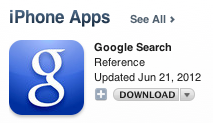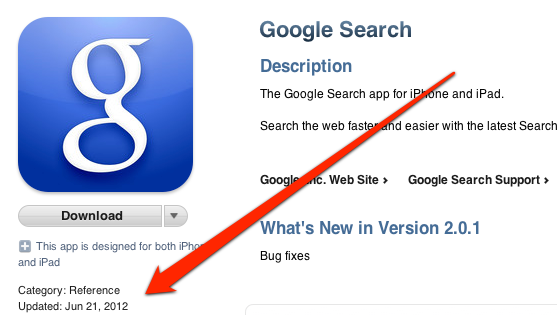Still Stuck Behind Apple’s Doors: The New Google Search App
Two months ago, Google previewed a new Google Search app that it said would be coming to iOS, bringing with it what seemed a blend of Siri and Google Now-like features. Despite being submitted to the Apple App Store back then, Apple’s still not approved the app. Why not? Apple didn’t have any comment, when I […]

Why not? Apple didn’t have any comment, when I asked last week. When I checked with Google, it simply reiterated what it said in August, that the app has been submitted. That leaves us with guesswork about why the app remains in limbo.
Too Close To Core Functionality?
One guess is that Apple doesn’t like that you can both talk to the app and have it talk back to you with answers. That’s what Siri does, and Siri is a “native” or “core” feature on the iPhone. Apple has sometimes blocked apps that seem to replicate core iOS features, as was the case with the Google Voice app several years ago.
Technically, Apple didn’t reject the Google Voice app. Rather, as it explained to the US Federal Communications Commission, it was continuing to study it:
Contrary to published reports, Apple has not rejected the Google Voice application, and continues to study it. The application has not been approved because, as submitted for review, it appears to alter the iPhone’s distinctive user experience by replacing the iPhone’s core mobile telephone functionality and Apple user interface with its own user interface for telephone calls, text messaging and voicemail.
Apple spent a lot of time and effort developing this distinct and innovative way to seamlessly deliver core functionality of the iPhone. For example, on an iPhone, the “Phone” icon that is always shown at the bottom of the Home Screen launches Apple’s mobile telephone application, providing access to Favorites, Recents, Contacts, a Keypad, and Visual Voicemail.
The Google Voice application replaces Apple’s Visual Voicemail by routing calls through a separate Google Voice telephone number that stores any voicemail, preventing voicemail from being stored on the iPhone, i.e., disabling Apple’s Visual Voicemail.
Similarly, SMS text messages are managed through the Google hub—replacing the iPhone’s text messaging feature. In addition, the iPhone user’s entire Contacts database is transferred to Google’s servers, and we have yet to obtain any assurances from Google that this data will only be used in appropriate ways.
These factors present several new issues and questions to us that we are still pondering at this time.
The Google Voice app that eventually was approved is a pretty poor experience compared to what happens with Google Voice on Android. There’s no ability to place calls, make text messages or hear voicemail using the iPhone’s native features working in conjunction with Google Voice. Everything has to be done through the Google Voice app.
But What About Maps Alternatives?
Of course, there are apps Apple does allow that arguably replicate native functionality. In fact, Apple CEO Tim Cook himself recommended some at the end of last month, when apologizing for the poor experience with the new Apple Maps. He suggested alternative mapping apps to Apple’s own Maps app. Apple’s even been promoting these within iTunes.
Let Consumers Choose What They Want
Personally, I dislike anyone trying to control what I can do with my own phone.
I’m not happy that Verizon stands in the way of Google Wallet on my Galaxy Nexus because it has its own Wallet rival it wants to push (and especially annoyed that after I got it finally working this summer, Verizon just jerked it away again).
I’m not happy that Google might have kept the turn-by-turn directions of Google Maps off iOS in order to prop-up Android. Nor am I happy that Apple might be keeping an updated Google Search app off simply to protect Siri.
If anything, the entire mess that has emerged over Apple Maps should underscore that most people don’t buy nor abandon a phone over one particular feature. There haven’t been reports of mass returns of the iPhone 5 despite Apple’s own admitted problems with Apple Maps. People like the iPhone 5 for reasons beyond that.
Similarly, Apple customers may prefer to use the iPhone 5 (and other iOS devices) with a better Google Search app even if that seems Siri-like, rather than potentially decide they should eventually jump ship to Android. In contrast, if they can’t get things they want from Google on an Apple device, that seems the bigger threat.
While we wait, the existing Google Search app remains available for the iPhone and iPad. You can even speak to it and make your requests. It just won’t read back to you answers in the way that those who use voice search on Android 4.1 “Jelly Bean” devices get.
Postscript: The app has now been approved. See our post, New Google Search App With Siri-Like Voice Responses Finally Approved For iOS and How Google’s New Search App For The iPhone Might Steal Searchers Away From Siri.
Related Articles
- iOS Users To Get Enhanced Google Search App Ahead Of Most Android Users
- Google Introduces Redesigned Mobile Search Experience, “Google Now” And Siri-Like Assistant
- Apple Asks For Patience, Would It Block A Google Maps App?
- Reports: Google Incredibly Didn’t Anticipate Being Dropped From iOS 6 Maps, “Scrambling” To Create App
- After Apple’s Apology, What’s Next For iOS 6 Maps?
- Apple Maps “Debacle” Probably Secures Google’s Default Search Position On iPhone In Perpetuity
- Google Maps Mobile Gets Street View, Aimed At Helping iOS Users
- Google Maps For Mobile: An iPhone User’s Guide
Opinions expressed in this article are those of the guest author and not necessarily Search Engine Land. Staff authors are listed here.
Related stories
